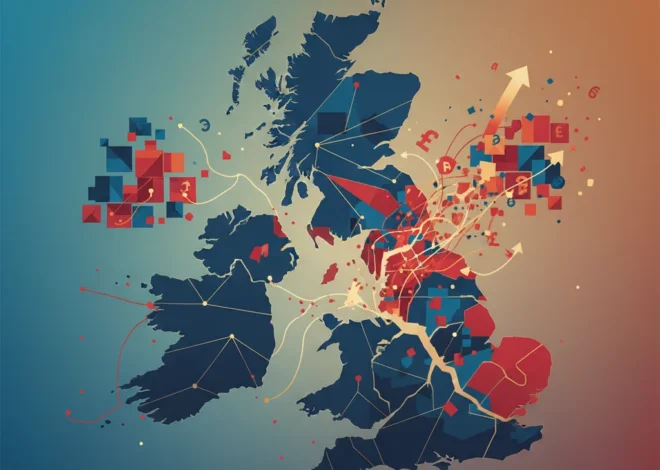
The Scottish Rental Crisis: A Canary in the Coal Mine for the UK Economy?
The simple question posed in a recent BBC feature, “What do you think about the cost of renting in Scotland?”, opens a Pandora’s box of economic complexities that extend far beyond the borders of Edinburgh or Glasgow. On the surface, it’s a question about affordability and housing. Dig deeper, however, and you uncover a narrative deeply intertwined with national finance, monetary policy, and the very future of investing. The soaring rents are not just a social issue; they are a critical symptom of broader macroeconomic pressures, a canary in the coal mine for the wider UK economy.
For tenants, the situation is a monthly struggle against stagnant wages and escalating living costs. For investors, it’s a complex puzzle of regulatory pressures and shifting yields. For business leaders, it’s a looming threat to talent acquisition and retention. This article will dissect the anatomy of Scotland’s rental crisis, explore its far-reaching economic implications, and analyze how innovations in financial technology and even blockchain could offer a glimpse of a more sustainable future.
Decoding the Numbers: The Stark Reality of Scotland’s Rental Market
Understanding the gravity of the situation begins with the data. The Scottish rental market has experienced unprecedented price inflation in recent years, far outpacing wage growth and creating a significant affordability gap. This isn’t just anecdotal; it’s a statistical reality driven by a classic, yet severe, supply and demand imbalance.
According to data from the Office for National Statistics (ONS), private rental prices in Scotland saw an annual increase of 11.6% in the 12 months to February 2024, a figure that highlights a market under intense strain. This surge is the result of several converging factors: a chronic undersupply of new housing, increased demand in urban centers, and the rising costs of borrowing for landlords, which are inevitably passed on to tenants.
To put this into perspective, let’s examine the average rental costs in Scotland’s two largest cities over time. The following table illustrates the rapid escalation that has left many residents feeling squeezed.
| City | Average Rent (2-Bed Property) Q1 2021 | Average Rent (2-Bed Property) Q1 2024 | Percentage Increase |
|---|---|---|---|
| Edinburgh | £1,150 | £1,477 | +28.4% |
| Glasgow | £950 | £1,253 | +31.9% |
Source: Data synthesized from reports by Citylets Scotland and market analysis.
This relentless climb in rental prices acts as a significant drag on the local economy. When a larger portion of disposable income is allocated to housing, consumer spending on retail, hospitality, and other services inevitably declines. This ripple effect can stifle growth for small and medium-sized enterprises, which form the backbone of the national economy.
A Tax on Prudence? Unpacking the Rumored Cuts to the UK's Cash ISA Allowance
From Holyrood to the Stock Market: Broader Economic Implications
The Scottish rental crisis is not an isolated phenomenon. It is a reflection of, and a contributor to, wider trends in the UK’s financial landscape. For finance professionals and investors, the dynamics at play offer crucial insights into market sentiment and risk.
The traditional “buy-to-let” investment model, once a cornerstone of many portfolios, is facing a perfect storm. Government interventions, such as rent caps and increased regulation, aim to protect tenants but simultaneously reduce the appeal for landlords. When you compare the potential yields from property against less capital-intensive assets on the stock market, the risk-reward calculation has fundamentally changed. An investor must now weigh the potential for capital appreciation against regulatory uncertainty, rising maintenance costs, and higher interest rates on mortgages, a direct consequence of central banking policy.
Furthermore, an unaffordable rental market poses a direct threat to business competitiveness. Major economic hubs like Edinburgh, a growing center for tech and finance, risk losing their competitive edge if they cannot house the skilled workforce they need to attract. Business leaders must now factor housing affordability into their strategic planning, as it directly impacts their ability to recruit and retain top talent.
Can Technology Solve a Housing Crisis? Exploring New Financial Models
While policy and construction are long-term solutions, the immediate pressures on the market are creating fertile ground for innovation, particularly from the world of financial technology (fintech).
Fintech for Renters and Landlords
A new wave of “PropTech” (Property Technology) companies is emerging to address specific pain points in the rental ecosystem. These platforms offer services like:
- Rent-to-Own Models: Fintech platforms are creating structured pathways for tenants to build equity over time, turning a portion of their rent into a down payment.
- Deposit Alternatives: Insurance-based products are replacing traditional large cash deposits, lowering the barrier to entry for tenants and reducing administrative burdens for landlords.
- Credit Building: Services that report timely rent payments to credit agencies, allowing tenants to build their credit history through their largest monthly expense.
These innovations in fintech are not a silver bullet, but they represent a significant step towards a more efficient, transparent, and equitable rental market.
The Blockchain Frontier: Tokenization and Fractional Ownership
Looking further ahead, blockchain technology presents a radical new paradigm for real estate investing. The concept of “property tokenization” involves converting the equity of a property into digital tokens that can be bought and sold on a digital marketplace. This has profound implications:
- Increased Liquidity: Real estate is notoriously illiquid. Tokenization could allow investors to buy and sell fractions of a property as easily as trading stocks.
- Democratized Access: By lowering the minimum investment amount, tokenization opens up property investment to a much wider audience that was previously priced out of the market.
- Transparency and Efficiency: Using smart contracts on a blockchain can automate lease agreements, rent collection, and dividend distributions to token holders, reducing administrative costs and potential for disputes. A report by the real estate firm Moore Global suggests that blockchain could streamline transactions and increase transparency across the industry (source).
Target's Strategic Reset: Why 1,800 Layoffs Signal a Deeper Shift in the Retail Economy
The table below contrasts the traditional model of property investment with a potential future enabled by these new technologies.
| Feature | Traditional Real Estate Investing | Fintech/Blockchain-Enabled Investing |
|---|---|---|
| Minimum Capital | High (Requires deposit, legal fees) | Low (Can buy fractional tokens for small amounts) |
| Liquidity | Very Low (Selling takes months/years) | High (Tokens can be traded 24/7 on exchanges) |
| Transaction Process | Complex, slow, involves many intermediaries | Streamlined via smart contracts, fewer intermediaries |
| Accessibility | Limited to accredited or wealthy investors | Globally accessible to anyone with an internet connection |
Strategic Plays for Investors and Business Leaders
Navigating this turbulent environment requires a sophisticated understanding of economics and a forward-looking investment strategy.
For investors, the direct buy-to-let market in high-pressure zones like Scotland now carries significant regulatory risk. Alternative strategies should be considered, such as investing in Real Estate Investment Trusts (REITs) that focus on build-to-rent developments, or allocating capital to PropTech venture funds that are building the tools of the future. The key is to diversify and gain exposure to the property sector without being overly exposed to the policy whims of a single region.
For business leaders, the housing crisis is a talent crisis in disguise. Companies in affected areas should consider how they can mitigate this challenge. This could range from offering more flexible remote work policies to, in some cases, exploring partnerships for employee housing solutions. Ignoring the issue is to ignore a fundamental factor in long-term workforce stability.
For finance professionals, the Scottish rental market serves as a valuable case study in the interplay between monetary policy, regulation, and asset performance. Key indicators to monitor include housing start numbers, inflation rates, and future moves by the Bank of England, as these will all dictate the future direction of the market.
The £20 Million Handshake: Inside Thames Water's Payout for a Deal That Never Happened
Conclusion: A Call for Integrated Solutions
The escalating cost of renting in Scotland is more than a headline; it’s a complex economic signal with deep-seated causes and wide-ranging effects. It highlights the fragility of a market caught between intense demand and insufficient supply, exacerbated by broader economic forces. While the challenges are immense, the path forward lies in an integrated approach. This requires sensible government policy that encourages supply, macroeconomic stability from central banking institutions, and the continued development of innovative financial technology that can make the housing market more accessible, efficient, and equitable for everyone involved. The future of housing, in Scotland and beyond, will be defined by our ability to balance the dual nature of property as a fundamental human need and a critical financial asset.


